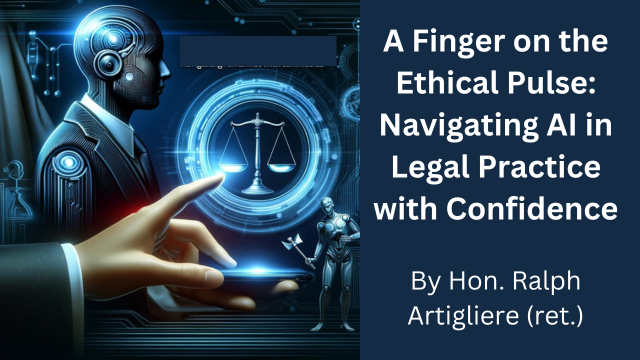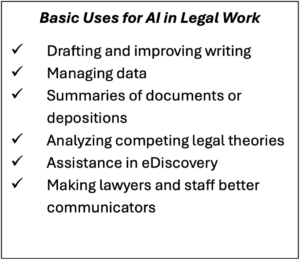
[Editor’s Note: EDRM is proud to publish the Hon. Ralph Artigliere’s (ret.) advocacy and analysis. The opinions and positions are Judge Artigliere’s (ret.) May 5, 2024 © Ralph Artigliere. This article was written for the third edition fireside chat on “Rise of the Machines III” which will be hosted on the EDRM Global Webinar Channel on May 21 at 1PM Eastern which can be accessed here.]
In the fast-evolving realm of artificial intelligence (AI), legal professionals face an imperative to not only keep up but to do so ethically and responsibly. As AI technologies permeate the legal industry, understanding their application and implications is essential. This article aims to provide lawyers with guidance on the importance of safely integrating AI into their practice, drawing on recent ethical opinions and practical insights.
To Delve or Not to Delve
No topic has dominated the legal industry more in the past year than the issue of when and how deep lawyers should dive into the AI pool. Since the waters are still murky, and the issues involve ethics, it is incumbent on organized and sanctioned Bar associations to develop reasoned and clear guidance to allow lawyers to safely navigate the waters without squelching the ability to capitalize on the benefits of AI for themselves and their clients. Guidance is coming with Florida (Ethics Opinion 24-1), California (Generative AI Practical Guidance), and a New York Task Force leading the way.
The ethical obligation to understand technology available for legal work goes both ways: Lawyers need to understand when technology can benefit them and their clients and should be safely used as well as when the risks outweigh the benefits. This means that sticking one’s head in the sand and waiting for the waters to clear on their own is not a sound option.
Imagine a lawyer holding off on using email and clinging to snail mail when email first came available.
The Hon. Judge Ralph Artigliere (ret.)
Clients are using AI, which yields two imperatives: (1) Clients will need lawyers to understand the emerging technologies to keep up with them and to be able to render legal advice about the many potential legal pitfalls that involve use of AI; and (2) Clients will expect their lawyers to capitalize on economic and efficient use of AI by their lawyers. Imagine a lawyer holding off on using email and clinging to snail mail when email first came available. The answer now is the same as it was then: learn, understand, and cautiously apply rather than stay on the sidelines when technology changes. The inevitable shift to AI cannot be ignored.
ETHICAL IMPLICATIONS
Keeping a finger on the pulse entails reading and understanding the ethical guidance from Bar associations and reliable sources. What is the emerging guidance telling lawyers about the most controversial tool, generative AI?
New Ethical Touchstones for Current Technology
The Florida Bar Ethics Opinion 24-1 provides that lawyers may use generative AI in their practice of law provided they “protect the confidentiality of client information, provide accurate and competent services, avoid improper billing practices, and comply with applicable restrictions on lawyer advertising.” While outlining the ethical guardrails for use of generative AI, the Florida opinion tellingly admits that “generative AI may have the potential to dramatically improve the efficiency of a lawyer’s practice.”
Likewise, the first sentence of the California PRACTICAL GUIDANCE FOR THE USE OF GENERATIVE ARTIFICIAL INTELLIGENCE IN THE PRACTICE OF LAW states: “Generative AI is a tool that has wide-ranging application for the practice of law and administrative functions of the legal practice for all licensees, regardless of firm size, and all practice areas.”
There are a substantial number of overall AI benefits, with the list growing daily. In general, AI: (i) efficiently performs repetitive tasks; (ii) reduces human error; (iii) increases efficiency; and (iv) augments human intelligence. Specific to the legal industry, AI has the potential to facilitate greater access to justice.
New York State Bar Association Task Force on Artificial Intelligence’s Report and Recommendations,at *20 (April 4, 2024), pending until officially adopted by the House of Delegates.
On April 4, 2024, the New York State Bar Association Task Force on Artificial Intelligence issued a Report and Recommendations (still pending until officially adopted by the House of Delegates). The Report was prepared by an impressive group of task force members and provides useful information on the history and characteristics of the technology as well as the ethical applications in law. The Report at p. 20 states that “There are a substantial number of overall AI benefits, with the list growing daily. In general, AI: (i) efficiently performs repetitive tasks; (ii) reduces human error; (iii) increases efficiency; and (iv) augments human intelligence. Specific to the legal industry, AI has the potential to facilitate greater access to justice.”
The ethical construct and guidance thus far do not prohibit the use of generative AI. To the contrary, the guidance urges responsible use and the ethical construct permits it with cautions and guardrails. Responsible use requires lawyers to understand the technology. This is not a new ethical construct by any means, as it was highlighted in 2012 when the ABA amended Comment 8 to Rule 1.1 to emphasize that, “a lawyer should keep abreast of changes in the law and its practice, including the benefits and risks associated with relevant technology… .” Most states have followed suit in their own ethical codes and guidance.
Comment 8 and its progeny provide broad and nonspecific guidance for good reason. Technology evolves and changes constantly. In the current paradigm shift involving artificial intelligence tools and platforms, change occurs daily. Now more than ever, Comment 8 yields incredibly important guidance that lawyers must heed for the good of justice and for their own benefit and that of their clients. Where specifics are needed, it appears that Bar Associations and other authorities will fill the gap.
But for lawyers who take the step to understand the technological lay of the land, including the benefits and risks associated with relevant technology, application of their own ethical compass can keep them safe pending further guidance from responsible authorities. Legal professionals learn ethics and professionalism in law school and are tested on the Bar exam. Fundamentally, we understand that ethics means doing the right thing, and finding specific authorization or compulsion to act a certain way is not needed. Our ethical compass guides the way. In the realm of technological tool availability, understanding the tools we use frees us to follow our ethical compass safely and effectively. You can do this.
PRACTICAL GUIDANCE FOR EMBRACING EMERGING TECHNOLOGY
Reading about generative AI does not alone impart a depth of understanding necessary for ethical and safe use of emerging technology such as generative AI. Using it in safe scenarios adds depth and perspective to information gained from reading and watching demonstrations.
Learn About the Technology and Keep a Finger on the Pulse
Studying generative AI requires a fundamental to moderate understanding about how Large Language Models work and how they are created, trained, updated, and properly employed. AI output containing bias and hallucinations are dangers to avoid, and lawyers must review and check output for these problems.
It does not take a lawyer an inordinate amount of time to know and understand the tools that are used in critical task of legal work product. Gaining base knowledge and staying up to date with evolution of the tools allows the user to avoid pitfalls and maximize the benefits of the platform.
Careful Use of AI Can Reap Great Benefits
Generative AI significantly enhances legal workflows, improving efficiency and performance in both mundane and complex tasks. Through my series of interviews for “Rise of the Machines: A Deeper Dive into Transition to Generative AI in Law Practice,” I’ve explored how these technologies extend beyond basic assistance to become crucial tools in legal practice. AI excels in areas where humans may falter, such as processing vast amounts of data quickly, performing repetitive tasks, and generating analytical solutions without fatigue.

However, humans still surpass AI in creativity, ethical judgment, and specialized knowledge. The synergy between human insight and AI’s capabilities can lead to superior outcomes when both are utilized correctly. For instance, AI can handle tasks ranging from routine administrative duties to more complex activities like drafting legal documents, analyzing legal theories, and managing eDiscovery processes.
The effective use of AI in law requires understanding its strengths and limitations, recognizing ethical boundaries, and maintaining rigorous oversight of its applications. Starting with simpler applications can help build familiarity and confidence. For those needing more guidance, consulting with experts can optimize AI integration. A deeper understanding of AI allows legal professionals to leverage this technology safely and effectively.
STEPS FOR SUCCESS WITH EMERGING AI TOOLS
Understanding AI’s capabilities and limitations is the first step towards its ethical application. Here’s how lawyers can start integrating AI into their workflows:
1. Start with a Solid Foundation
Gain a basic understanding of how large language models (LLMs) like generative AI operate. Recognize that while AI can perform data-heavy tasks with remarkable efficiency, it may also produce biased outputs or “hallucinate” details, such as fabricating legal precedents. There is a great deal of information available. For example, check out Merlin’s free eBook “GenAI for Smart People- An Introduction to Large Language Models for Smart Ediscovery Professionals” found at https://www.merlin.tech/genai-for-smart-people/.
2. Monitor the Field and Learn from the Failure of Others
Consider the case of a New York lawyer who faced sanctions after failing to verify AI-generated legal citations—a stark reminder of the need for diligence in using AI tools. Mata v. Avianca, 22-cv-1461, 2023 U.S. Dist. LEXIS 108263, 2023 WL 41149658 (S.D.N.Y. June 22, 2023). The lesson is obvious: check AI work product like you would the work of a law clerk or new associate. Shockingly, others continue to make this pathetic mistake. Park v. Kim, 91 F.4th 610, 2024 U.S. App. LEXIS 1996, 2024 WL 332478 (2d Cir. Dec. 15, 2023)(the duties imposed by Fed. R. Civ. P. 11 require that attorneys read, and thereby confirm the existence and validity of, the legal authorities on which they rely). Under Comment 8, ignorance of the technology is no excuse. And courts will not abide it.

3. Apply AI Cautiously
Implement AI in lower-risk areas first, such as automating administrative tasks or conducting preliminary research, before relying on it for more critical applications like drafting legal documents or advising clients. Many applications for AI tools and methods of using them do not involve potential pitfalls regarding client confidentiality, hallucinations, or bias.
4. Continuously Check for Bias and Accuracy
Regularly review AI outputs for potential biases or inaccuracies. This involves understanding the data on which the AI was trained and being vigilant about its recommendations. Always check the work and keep a human in the loop.
5. Keep Updated and Collaborate
Stay informed about the latest developments in AI technology and ethical guidelines. Engage with colleagues and technology experts to share experiences and best practices. There are many free resources available. I stay updated with resources and programs from EDRM Education and News, JDSupra, the eDiscovery Today Blog and bi-weekly updates from Josh Kubicki at Brainyacts. The University of Florida eDiscovery Conferenceis an annual event free online and minimal charge in person for two days of excellent instruction and updates on AI and eDiscovery from world class presenters. There are many other sources of information, some better than others. But I find the technology community to be incredibly sharing with their expertise and knowledge. Many of us are on a mission to assist the legal community with a safe and effective transition to emerging technologies. Tap in, learn, and stay updated.
6. Learn to Use AI Platforms
Proper use can eliminate risk, increase efficiency, and avoid rabbit trails. For example, learn to prompt Generative AI models. “Prompt engineering” is an essential skill for generative AI just like learning to research on Westlaw and Lexis required query skills and understanding of the platforms. Lawyers used to search engines like Google or legal research on Lexis or Westlaw are prone to using requests with minimal information, often consisting of key words. Prompting generative AI tools entails more specific and contextual queries, especially in the legal realm where precision in responses is critical.
Information on effective prompts is often available from the platforms themselves, but it takes practice and sometimes further study to perfect the techniques. Once a sufficient base of knowledge is obtained from experience and study, lawyers can calibrate their ethical compass regarding technology and open up the promise of efficiency, economy, and excellence of work product. More importantly, the foundational knowledge allows them to keep a finger on the pulse and soar above the rest as technology improves for their benefit and that of their clients.
7. Choose the Correct Tools
AI products come in many varieties with various costs and levels of subscriptions from free versions to paid subscriptions. Legal tools that incorporate AI are also emerging. Take the time to understand the products and their application to your workflow and needs before committing to a path. This is an area in which expert assistance is vital for sufficient enlightenment and application. I have learned from my Rise of the Machines odyssey that it is incumbent on lawyers as legal professionals and as managers to understand the technology they use or retain the assistance they need to properly use it. I am confident this is within their power. My next Rise of the Machines interview, Rise of the Machines III, on May 21 at 1:00 pm. Eastern and can be accessed here..
Conclusion: Embrace AI with Ethical Vigilance
Legal professionals are no strangers to the need for continual learning and ethical vigilance. AI represents both a challenge and an opportunity—a tool that, when used wisely, can augment our capabilities and offer significant advantages in efficiency and service quality.
As aptly stated by the court in Mata v. Avianca, 22-cv-1461, 2023 U.S. Dist. LEXIS 108263*1, 2023 WL 41149658 at 1 (S.D.N.Y. June 22, 2023) “[t]echnological advances are commonplace and there is nothing inherently improper about using a reliable artificial intelligence tool for assistance.” Ethical opinions and guidance have followed that lead while establishing guardrails for use of emerging technology like generative AI.
Echoing the sentiments expressed in Mata v. Avianca, the integration of AI in legal practice is not just permissible but advisable, provided it is approached with care and responsibility. By understanding and embracing AI, lawyers can ensure they remain at the forefront of their profession, ready to meet the needs of their clients in the digital age with competence and integrity.
May 5, 2024 © Ralph Artigliere. ALL RIGHTS RESERVED (Published on edrm.net with permission.)
NOTE: Generative AI products were used to help review this article per EDRM GAI and LLM Policy.


